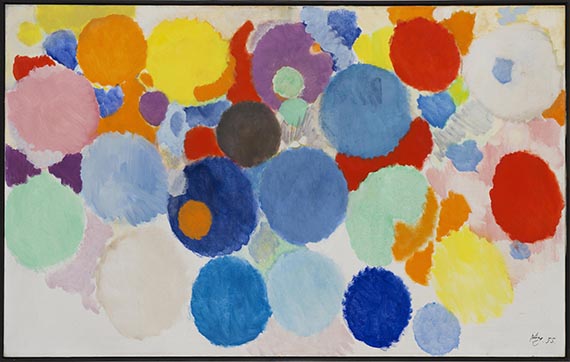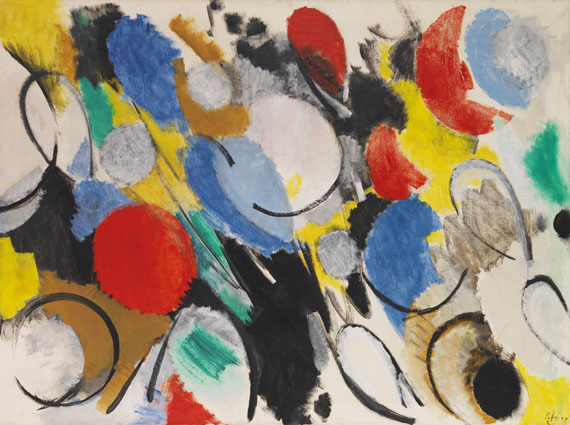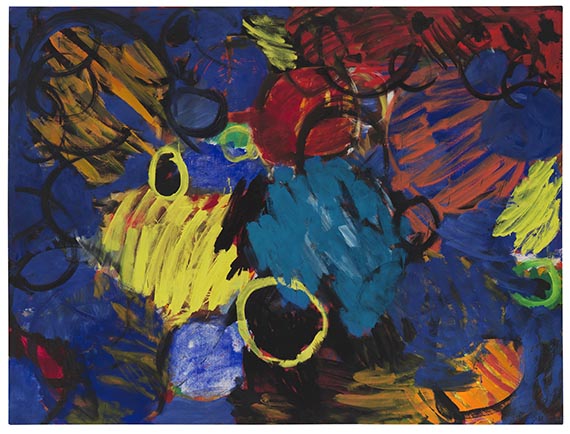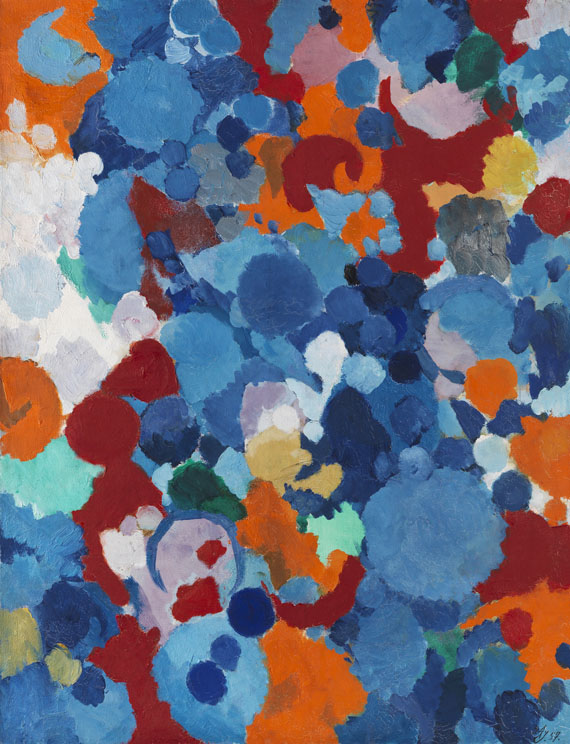30
Ernst Wilhelm Nay
Ene mene ming mang, 1955.
Oil on canvas
Estimate:
€ 400,000 - 600,000
$ 428,000 - 642,000
Ene mene ming mang. 1955.
Oil on canvas.
Lower right signed and dated. Once more signed on the reverse, stretcher inscribed "E. W. Nay - "Ene-mene-ming-mang" - 1955" and with the direction. 125 x 200 cm (49.2 x 78.7 in).
With a label of Galerie Günther Franke, Munich, on the reverse. [AR.
• Floating lightness in a large format.
• Museum quality, from the famous group of the “Disk Pictures”, inharmonious colors.
• Inimitable synthesis of title and composition.
• “Ene mene ming mang”: a traditional nursery rhyme that conveys cheerfulness.
• The disk becomes the painterly dominant form in a beautifully shaped pictorial rhythm.
• As early as 1957, Nay exhibited two of his “Disk Pictures” in the exhibition “German Art of the Twentieth Century” at the Museum of Modern Art.
• Comparable works from this series are at, among others, the Museum Folkwang, Essen, the Bavarian State Painting Collections, Munich and the Solomon R. Guggenheim Museum, New York.
PROVENANCE: Elisabeth Nay-Scheibler, Cologne.
Private collection North Rhine-Westphalia (since 1996).
EXHIBITION: E. W. Nay. Bilder aus den Jahren 1935-1968. Retrospektive, Museum Städtische Kunstsammlungen, Bonn, January 27 - March 1, 1970, cat. no. 22 (color plate).
E. W. Nay 1902-1968 – Bilder und Dokumente. Retrospektive, Germanisches Nationalmuseum, Nuremberg, March 29 - June 1, 1980, Haus der Kunst, Munich, July 26 - September 21, 1980, Erholungshaus der Bayer AG, Leverkusen, September 28 - October 30, 1980, Wilhelm-Hack-Museum, Ludwigshafen a. Rh., December 7, 1980 - February 1, 1981, Neue Galerie, Kassel, March 14 - May 10, 1981, cat. no. 36 (illu. no. 72, p. 129).
Ernst Wilhelm Nay, Stedelijk Museum, Amsterdam, April 30 - June 10, 1998, Gemäldegalerie Neue Meister, Dresden, July 19 - August 16, 1998, Wilhelm-Lehmbruck-Museum, Duisburg, August 23 - October 11, 1998, cat. no. 28 (illu. on p. 64).
LITERATURE: Aurel Scheibler, Siegfried Gohr, Ernst Wilhelm Nay. Catalogue raisonné of oil paintings, vol. 2: 1952-1968, Cologne 1990, no. 784 (color illu.).
--
Peter-Klaus Schuster, Kunst im Kontext: E. W. Nays ständige Wandlung,in: E. W. Nay - Bilder und Dokumente, Munich 1980, pp. 7-16, here p. 12 (illu. on p. 129).
Karin Schick, Kontakt. Zur Bedeutung von Sprache bei Ernst Wilhelm Nay, in: Karin Schick, Sophia Colditz, Roman Zieglgänsberger (ed.), E. W. Nay. Retrospektive, Cologne 2022, pp. 16-27, here p. 18.
Called up: June 7, 2024 - ca. 17.58 h +/- 20 min.
Oil on canvas.
Lower right signed and dated. Once more signed on the reverse, stretcher inscribed "E. W. Nay - "Ene-mene-ming-mang" - 1955" and with the direction. 125 x 200 cm (49.2 x 78.7 in).
With a label of Galerie Günther Franke, Munich, on the reverse. [AR.
• Floating lightness in a large format.
• Museum quality, from the famous group of the “Disk Pictures”, inharmonious colors.
• Inimitable synthesis of title and composition.
• “Ene mene ming mang”: a traditional nursery rhyme that conveys cheerfulness.
• The disk becomes the painterly dominant form in a beautifully shaped pictorial rhythm.
• As early as 1957, Nay exhibited two of his “Disk Pictures” in the exhibition “German Art of the Twentieth Century” at the Museum of Modern Art.
• Comparable works from this series are at, among others, the Museum Folkwang, Essen, the Bavarian State Painting Collections, Munich and the Solomon R. Guggenheim Museum, New York.
PROVENANCE: Elisabeth Nay-Scheibler, Cologne.
Private collection North Rhine-Westphalia (since 1996).
EXHIBITION: E. W. Nay. Bilder aus den Jahren 1935-1968. Retrospektive, Museum Städtische Kunstsammlungen, Bonn, January 27 - March 1, 1970, cat. no. 22 (color plate).
E. W. Nay 1902-1968 – Bilder und Dokumente. Retrospektive, Germanisches Nationalmuseum, Nuremberg, March 29 - June 1, 1980, Haus der Kunst, Munich, July 26 - September 21, 1980, Erholungshaus der Bayer AG, Leverkusen, September 28 - October 30, 1980, Wilhelm-Hack-Museum, Ludwigshafen a. Rh., December 7, 1980 - February 1, 1981, Neue Galerie, Kassel, March 14 - May 10, 1981, cat. no. 36 (illu. no. 72, p. 129).
Ernst Wilhelm Nay, Stedelijk Museum, Amsterdam, April 30 - June 10, 1998, Gemäldegalerie Neue Meister, Dresden, July 19 - August 16, 1998, Wilhelm-Lehmbruck-Museum, Duisburg, August 23 - October 11, 1998, cat. no. 28 (illu. on p. 64).
LITERATURE: Aurel Scheibler, Siegfried Gohr, Ernst Wilhelm Nay. Catalogue raisonné of oil paintings, vol. 2: 1952-1968, Cologne 1990, no. 784 (color illu.).
--
Peter-Klaus Schuster, Kunst im Kontext: E. W. Nays ständige Wandlung,in: E. W. Nay - Bilder und Dokumente, Munich 1980, pp. 7-16, here p. 12 (illu. on p. 129).
Karin Schick, Kontakt. Zur Bedeutung von Sprache bei Ernst Wilhelm Nay, in: Karin Schick, Sophia Colditz, Roman Zieglgänsberger (ed.), E. W. Nay. Retrospektive, Cologne 2022, pp. 16-27, here p. 18.
Called up: June 7, 2024 - ca. 17.58 h +/- 20 min.
"Ene mene ming mang" - und Du bist dran! (Similar to: Eeny, meeny, miny, moe,
Catch a tiger by the toe) Title and composition - a children's counting-out rhyme.
Even the title "Ene mene ming mang" promises a great deal of amusement. Literally an exception for a title that Ernst Wilhelm Nay gives to the completed painting in his final contemplation, associated with a delightful thought, reminiscent of a counting-out rhyme: 'Ene mene ming mang', the first sentence of the traditional children's rhyme that children use to count out a person in a game.
Nay himself described his path to the legendary compositions of the "Disk Paintings" in the following words: "So I started with innocuous new experiments and I realized: If I touch the canvas with a brush, I get a small blob, if I enlarge it, I get a disk. Of course, this disk already does a lot to the surface. If I add more disks, a system of colors and quantitative proportions emerges, which can now be combined and combined to form larger pictorial structures." (Magdalene Claesges, E. W. Nay. Lesebuch, Selbstzeugnisse und Schriften, Cologne 2002, p. 226).
Gestural forms and bright, circular splashes of color proliferate across the picture, taking on a lyrical, almost rhythmic form and reflect the artist's mood. Spots and densely painted circles in white, lemon yellow, dark yellow, orange, pink, light red, violet, light blue, dark blue, turquoise, light green and light gray bring the composition to life. The colors are colors are vibrant and effective, a free, musical aesthetic with painted circular shapes. The artist staged a seemingly weightless pictorial scene that "virtually brims over with joie de vivre, rhythm, colorful splendor, rapid strokes and energetic movement", according to art historian and Nay expert Siegfried Gohr. (In: Ernst Wilhelm Nay - An Essay, in: Exhibition catalog, Stedelijk Museum, Amsterdam, 1998, p. 27).
Nay increasingly isolated this incomparably powerful form of the round disk and reduced the inventory of forms in his painting: The disks, the motif of the disk, becomes the painterly determinant of a beautifully shaped pictorial rhythm. The painter was fascinated with this discovery: the circle, this archetypal form with its infinite associations, color transformations and modulations, became the vehicle of a colorful rhythmic development of round disks in changing intensity. With "Ene mene ming mang", Nay created a wonderful painting characterized by a bright and cheerful radiance. With its thin watercolor-like application, the paint loses its material character: it appears spiritual and carries us off into a wide-open, infinite space.
There is a vague dominance between the strong red, the deep blue and bright yellow, a condensed movement of the disks from the bottom right to the top left can perhaps be recognized. This 'movement' is supported by admixture, a light and brightly delicate modulation is rhythmically staged here and there like a dampening of the colors' purity. Warm and at times rather cool modulations enhance the finely balanced presence of the motif. And the distances between the colors, their overlapping and permeating movements create a spatial oscillation that spreads like waves across the canvas. The potential extension of the disks is evidently not restricted by the limits of the format.
]
Catch a tiger by the toe) Title and composition - a children's counting-out rhyme.
Even the title "Ene mene ming mang" promises a great deal of amusement. Literally an exception for a title that Ernst Wilhelm Nay gives to the completed painting in his final contemplation, associated with a delightful thought, reminiscent of a counting-out rhyme: 'Ene mene ming mang', the first sentence of the traditional children's rhyme that children use to count out a person in a game.
Nay himself described his path to the legendary compositions of the "Disk Paintings" in the following words: "So I started with innocuous new experiments and I realized: If I touch the canvas with a brush, I get a small blob, if I enlarge it, I get a disk. Of course, this disk already does a lot to the surface. If I add more disks, a system of colors and quantitative proportions emerges, which can now be combined and combined to form larger pictorial structures." (Magdalene Claesges, E. W. Nay. Lesebuch, Selbstzeugnisse und Schriften, Cologne 2002, p. 226).
Gestural forms and bright, circular splashes of color proliferate across the picture, taking on a lyrical, almost rhythmic form and reflect the artist's mood. Spots and densely painted circles in white, lemon yellow, dark yellow, orange, pink, light red, violet, light blue, dark blue, turquoise, light green and light gray bring the composition to life. The colors are colors are vibrant and effective, a free, musical aesthetic with painted circular shapes. The artist staged a seemingly weightless pictorial scene that "virtually brims over with joie de vivre, rhythm, colorful splendor, rapid strokes and energetic movement", according to art historian and Nay expert Siegfried Gohr. (In: Ernst Wilhelm Nay - An Essay, in: Exhibition catalog, Stedelijk Museum, Amsterdam, 1998, p. 27).
Nay increasingly isolated this incomparably powerful form of the round disk and reduced the inventory of forms in his painting: The disks, the motif of the disk, becomes the painterly determinant of a beautifully shaped pictorial rhythm. The painter was fascinated with this discovery: the circle, this archetypal form with its infinite associations, color transformations and modulations, became the vehicle of a colorful rhythmic development of round disks in changing intensity. With "Ene mene ming mang", Nay created a wonderful painting characterized by a bright and cheerful radiance. With its thin watercolor-like application, the paint loses its material character: it appears spiritual and carries us off into a wide-open, infinite space.
There is a vague dominance between the strong red, the deep blue and bright yellow, a condensed movement of the disks from the bottom right to the top left can perhaps be recognized. This 'movement' is supported by admixture, a light and brightly delicate modulation is rhythmically staged here and there like a dampening of the colors' purity. Warm and at times rather cool modulations enhance the finely balanced presence of the motif. And the distances between the colors, their overlapping and permeating movements create a spatial oscillation that spreads like waves across the canvas. The potential extension of the disks is evidently not restricted by the limits of the format.
]
30
Ernst Wilhelm Nay
Ene mene ming mang, 1955.
Oil on canvas
Estimate:
€ 400,000 - 600,000
$ 428,000 - 642,000
Buyer's premium, taxation and resale right compensation for Ernst Wilhelm Nay "Ene mene ming mang"
This lot can be purchased subject to differential or regular taxation, artist‘s resale right compensation is due.
Differential taxation:
Hammer price up to 800,000 €: herefrom 32 % premium.
The share of the hammer price exceeding 800,000 € is subject to a premium of 27 % and is added to the premium of the share of the hammer price up to 800,000 €.
The share of the hammer price exceeding 4,000,000 € is subject to a premium of 22 % and is added to the premium of the share of the hammer price up to 4,000,000 €.
The buyer's premium contains VAT, however, it is not shown.
Regular taxation:
Hammer price up to 800,000 €: herefrom 27 % premium.
The share of the hammer price exceeding 800,000 € is subject to a premium of 21% and is added to the premium of the share of the hammer price up to 800,000 €.
The share of the hammer price exceeding 4,000,000 € is subject to a premium of 15% and is added to the premium of the share of the hammer price up to 4,000,000 €.
The statutory VAT of currently 19 % is levied to the sum of hammer price and premium. As an exception, the reduced VAT of 7 % is added for printed books.
We kindly ask you to notify us before invoicing if you wish to be subject to regular taxation.
Calculation of artist‘s resale right compensation:
For works by living artists, or by artists who died less than 70 years ago, a artist‘s resale right compensation is levied in accordance with Section 26 UrhG:
4 % of hammer price from 400.00 euros up to 50,000 euros,
another 3 % of the hammer price from 50,000.01 to 200,000 euros,
another 1 % for the part of the sales proceeds from 200,000.01 to 350,000 euros,
another 0.5 % for the part of the sale proceeds from 350,000.01 to 500,000 euros and
another 0.25 % of the hammer price over 500,000 euros.
The maximum total of the resale right fee is EUR 12,500.
The artist‘s resale right compensation is VAT-exempt.
Differential taxation:
Hammer price up to 800,000 €: herefrom 32 % premium.
The share of the hammer price exceeding 800,000 € is subject to a premium of 27 % and is added to the premium of the share of the hammer price up to 800,000 €.
The share of the hammer price exceeding 4,000,000 € is subject to a premium of 22 % and is added to the premium of the share of the hammer price up to 4,000,000 €.
The buyer's premium contains VAT, however, it is not shown.
Regular taxation:
Hammer price up to 800,000 €: herefrom 27 % premium.
The share of the hammer price exceeding 800,000 € is subject to a premium of 21% and is added to the premium of the share of the hammer price up to 800,000 €.
The share of the hammer price exceeding 4,000,000 € is subject to a premium of 15% and is added to the premium of the share of the hammer price up to 4,000,000 €.
The statutory VAT of currently 19 % is levied to the sum of hammer price and premium. As an exception, the reduced VAT of 7 % is added for printed books.
We kindly ask you to notify us before invoicing if you wish to be subject to regular taxation.
Calculation of artist‘s resale right compensation:
For works by living artists, or by artists who died less than 70 years ago, a artist‘s resale right compensation is levied in accordance with Section 26 UrhG:
4 % of hammer price from 400.00 euros up to 50,000 euros,
another 3 % of the hammer price from 50,000.01 to 200,000 euros,
another 1 % for the part of the sales proceeds from 200,000.01 to 350,000 euros,
another 0.5 % for the part of the sale proceeds from 350,000.01 to 500,000 euros and
another 0.25 % of the hammer price over 500,000 euros.
The maximum total of the resale right fee is EUR 12,500.
The artist‘s resale right compensation is VAT-exempt.




 Lot 30
Lot 30 




